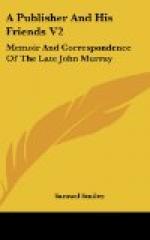There were many books in which the two houses had a joint interest, and, therefore, their relations could not be altogether discontinued. “Marmion” was coming out in successive editions; but the correspondence between the publishers grew cooler and cooler, and Constable had constant need to delay payments and renew bills.
Mr. Murray had also considerable bill transactions with Ballantyne & Co. of Edinburgh. James and John Ballantyne had been schoolfellows of Walter Scott at Kelso, and the acquaintance there formed was afterwards renewed. James Ballantyne established the Kelso Mail in 1796, but at the recommendation of Scott, for whom he had printed a collection of ballads, he removed to Edinburgh in 1802. There he printed the “Border Minstrelsy,” for Scott, who assisted him with money. Ballantyne was in frequent and intimate correspondence with Murray from the year 1806, and had printed for him Hogg’s “Ettrick Shepherd,” and other works.
It was at this time that Scott committed the great error of his life. His professional income was about L1,000 a year, and with the profits of his works he might have built Abbotsford and lived in comfort and luxury. But in 1805 he sacrificed everything by entering into partnership with James Ballantyne, and embarking in his printing concern almost the whole of the capital which he possessed. He was bound to the firm for twenty years, and during that time he produced his greatest works. It is true that but for the difficulties in which he was latterly immersed, we might never have known the noble courage with which he met and rose superior to misfortune.
In 1808 a scheme of great magnitude was under contemplation by Murray and the Ballantynes. It was a uniform edition of the “British Novelists,” beginning with De Foe, and ending with the novelists at the close of last century; with biographical prefaces and illustrative notes by Walter Scott. A list of the novels, written in the hand of John Murray, includes thirty-six British, besides eighteen foreign authors. The collection could not have been completed in less than two hundred volumes. The scheme, if it did not originate with Walter Scott, had at least his cordial support.
Mr. Murray not unreasonably feared the cost of carrying such an undertaking to completion. It could not have amounted to less than twenty thousand pounds. Yet the Ballantynes urged him on. They furnished statements of the cost of printing and paper for each volume. “It really strikes me,” said James Ballantyne, “the more I think of and examine it, to be the happiest speculation that has ever been thought of.”
This undertaking eventually fell through. Only the works of De Foe were printed by the Messrs. Ballantyne, and published by Mr. Murray. The attention of the latter became absorbed by a subject of much greater importance to him—the establishment of the Quarterly Review. This for a time threw most of his other schemes into the shade.




